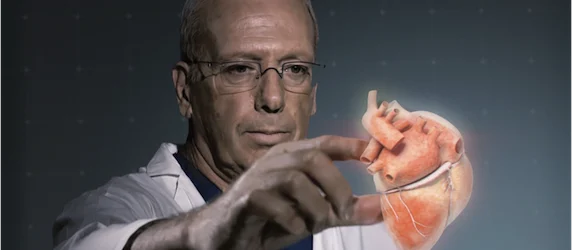A clinical study conducted in collaboration between Philips and RealView Imaging with the assistance of Israel’s Schneider Children’s Medical Center in Petach Tikva, has found that minimally-invasive structural heart disease procedures can be significantly aided by the use of a pioneering live 3D holographic visualisation technology developed by RealView. It displays real-time, interactive three dimensional holographic images obtained by Philips’ interventional X-ray and cardiac ultrasound systems.
During one such procedure conducted during the eight-patient study, the interventional team medics were able to view, unaided by any special eyewear, detailed dynamic 3D holographic images of the heart seemingly ‘floating’. Still referring to a 2D screen display of the patient’s heart, doctors were able to manipulate the projected 3D heart structures by actually touching the holograph in their reach, all the while demonstrating the technology’s potential to enhance the context and guidance of structural heart repairs.
Dr. Einat Birk, pediatric cardiologist and Director of the Institute of Pediatric Cardiology at Schneider Children’s Medical Center, is enthousiastic about the unprecedented projections. He states that this technology enables him to better comprehend the patient’s 3D spacial heart anatomy during the procedure, and consequently improve his device-tissue navigation and interaction. Paediatric cardiologist and Director of the Centre’s Cardiac Catheterization Laboratories, Dr. Elchanan Bruckheimer is equally positive, and adds that complex procedures will be made easier through the use of this innovative holographic imaging.
General Manager of Integrated Clinical Solutions and Marketing for Imaging Systems at Philips Healthcare Mr Bert van Meurs reiterates the company’s goal and ambition to create the future of healthcare. He goes on to say that it is teamwork with partners who share Philips’ passion for innovation which enabled them to showcase the feasibility and potential value of the world’s first holographic visualization technology.
“I see clear indications that 3D medical holography will play an important role in medical imaging in the near future,” said Aviad Kaufman, CEO of RealView Imaging Ltd., adding that the company is convinced their holographic technology will continue to improve 3D imaging and, more crucially, enhance patient care.
Whether it is the opening of obstructed coronary arteries, the catheter ablation therapy for heart arrhythmias and other catheter-based structural heart repairs such as heart valve replacements, the continual advances made in image-guided therapies for heart diseases have greatly increased the need for live 3D image guidance.
By supplementing holographic imaging with current 2D image guidance and live X-ray, doctors can benefit from a multi-dimensional approach in the minimally invasive structural heart repair procedures they conduct.
Based on the encouraging results obtained in this unprecedented study, Philips and RealView Imaging will carry on exploring the clinical value of combining live 3D imaging and medical holography, both in interventional cardiology and in other clinical areas.
Latest Articles
Philips, Heart, 3D imaging, RealView, 2D imaging
A clinical study conducted in collaboration between Philips and RealView Imaging with the assistance of Israel’s Schneider Children’s Medical Center in...










